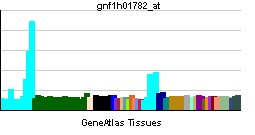ARID2
| AT rich interactive domain 2 (ARID, RFX-like) | |||||||||||
|---|---|---|---|---|---|---|---|---|---|---|---|
| Identifiers | |||||||||||
| Symbols | ARID2 ; p200; BAF200; DKFZp686G052; DKFZp779P0222; FLJ30619; KIAA1557 | ||||||||||
| External IDs | Template:OMIM5 Template:MGI HomoloGene: 14601 | ||||||||||
| |||||||||||
| RNA expression pattern | |||||||||||
 | |||||||||||
 | |||||||||||
| More reference expression data | |||||||||||
| Orthologs | |||||||||||
| Template:GNF Ortholog box | |||||||||||
| Species | Human | Mouse | |||||||||
| Entrez | n/a | n/a | |||||||||
| Ensembl | n/a | n/a | |||||||||
| UniProt | n/a | n/a | |||||||||
| RefSeq (mRNA) | n/a | n/a | |||||||||
| RefSeq (protein) | n/a | n/a | |||||||||
| Location (UCSC) | n/a | n/a | |||||||||
| PubMed search | n/a | n/a | |||||||||
AT rich interactive domain 2 (ARID, RFX-like), also known as ARID2, is a human gene.[1]
ARID2 is a subunit of the PBAF chromatin-remodeling complex (see BAF180; MIM 606083), which facilitates ligand-dependent transcriptional activation by nuclear receptors (Yan et al., 2005).[supplied by OMIM][1]
References
Further reading
- Martens JA, Winston F (2003). "Recent advances in understanding chromatin remodeling by Swi/Snf complexes". Curr. Opin. Genet. Dev. 13 (2): 136–42. PMID 12672490.
- Nagase T, Kikuno R, Nakayama M; et al. (2001). "Prediction of the coding sequences of unidentified human genes. XVIII. The complete sequences of 100 new cDNA clones from brain which code for large proteins in vitro". DNA Res. 7 (4): 273–81. PMID 10997877.
- Strausberg RL, Feingold EA, Grouse LH; et al. (2003). "Generation and initial analysis of more than 15,000 full-length human and mouse cDNA sequences". Proc. Natl. Acad. Sci. U.S.A. 99 (26): 16899–903. doi:10.1073/pnas.242603899. PMID 12477932.
- Ota T, Suzuki Y, Nishikawa T; et al. (2004). "Complete sequencing and characterization of 21,243 full-length human cDNAs". Nat. Genet. 36 (1): 40–5. doi:10.1038/ng1285. PMID 14702039.
- Mohrmann L, Langenberg K, Krijgsveld J; et al. (2004). "Differential targeting of two distinct SWI/SNF-related Drosophila chromatin-remodeling complexes". Mol. Cell. Biol. 24 (8): 3077–88. PMID 15060132.
- Brandenberger R, Wei H, Zhang S; et al. (2005). "Transcriptome characterization elucidates signaling networks that control human ES cell growth and differentiation". Nat. Biotechnol. 22 (6): 707–16. doi:10.1038/nbt971. PMID 15146197.
- Diederichs S, Bäumer N, Ji P; et al. (2004). "Identification of interaction partners and substrates of the cyclin A1-CDK2 complex". J. Biol. Chem. 279 (32): 33727–41. doi:10.1074/jbc.M401708200. PMID 15159402.
- Gerhard DS, Wagner L, Feingold EA; et al. (2004). "The status, quality, and expansion of the NIH full-length cDNA project: the Mammalian Gene Collection (MGC)". Genome Res. 14 (10B): 2121–7. doi:10.1101/gr.2596504. PMID 15489334.
- Patsialou A, Wilsker D, Moran E (2005). "DNA-binding properties of ARID family proteins". Nucleic Acids Res. 33 (1): 66–80. doi:10.1093/nar/gki145. PMID 15640446.
- Wilsker D, Probst L, Wain HM; et al. (2005). "Nomenclature of the ARID family of DNA-binding proteins". Genomics. 86 (2): 242–51. doi:10.1016/j.ygeno.2005.03.013. PMID 15922553.
- Yan Z, Cui K, Murray DM; et al. (2005). "PBAF chromatin-remodeling complex requires a novel specificity subunit, BAF200, to regulate expression of selective interferon-responsive genes". Genes Dev. 19 (14): 1662–7. doi:10.1101/gad.1323805. PMID 15985610.
- Otsuki T, Ota T, Nishikawa T; et al. (2007). "Signal sequence and keyword trap in silico for selection of full-length human cDNAs encoding secretion or membrane proteins from oligo-capped cDNA libraries". DNA Res. 12 (2): 117–26. doi:10.1093/dnares/12.2.117. PMID 16303743.
- Zhang X, Azhar G, Zhong Y, Wei JY (2006). "Zipzap/p200 is a novel zinc finger protein contributing to cardiac gene regulation". Biochem. Biophys. Res. Commun. 346 (3): 794–801. doi:10.1016/j.bbrc.2006.05.211. PMID 16782067.
External links
- ARID2+protein,+human at the US National Library of Medicine Medical Subject Headings (MeSH)
| This protein-related article is a stub. You can help Wikipedia by expanding it. |
This article incorporates text from the United States National Library of Medicine, which is in the public domain.